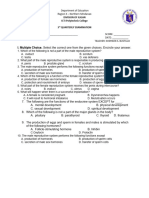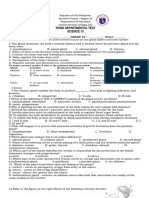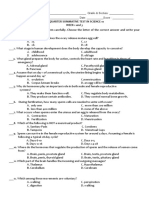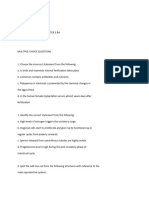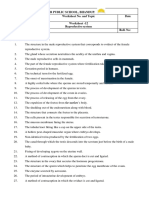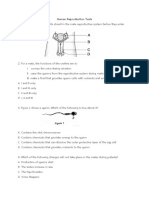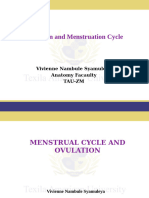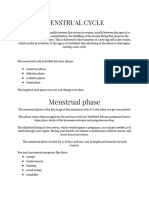0 ratings0% found this document useful (0 votes)
107 viewsModule 1 Science
This document discusses a performance task and post-test about human reproduction from a 10th grade science class. The performance task asks students to reflect on and answer questions about (a) the ethical implications of artificial reproduction technologies and (b) whether humans should be allowed to artificially reproduce. It also asks about the impact if these technologies did not exist for someone unable to reproduce naturally. The post-test has 10 multiple choice questions testing knowledge of the male and female reproductive systems and their controlling hormones.
Uploaded by
James Coth GuerreroCopyright
© © All Rights Reserved
Available Formats
Download as DOCX, PDF, TXT or read online on Scribd
0 ratings0% found this document useful (0 votes)
107 viewsModule 1 Science
This document discusses a performance task and post-test about human reproduction from a 10th grade science class. The performance task asks students to reflect on and answer questions about (a) the ethical implications of artificial reproduction technologies and (b) whether humans should be allowed to artificially reproduce. It also asks about the impact if these technologies did not exist for someone unable to reproduce naturally. The post-test has 10 multiple choice questions testing knowledge of the male and female reproductive systems and their controlling hormones.
Uploaded by
James Coth GuerreroCopyright
© © All Rights Reserved
Available Formats
Download as DOCX, PDF, TXT or read online on Scribd
You are on page 1/ 2
James Coth V.
Guerrero Bayawan City Science and Technology Education Center
January 22,2022 Science 10: 3rd Quarter
Module 1: Hormones in Human Reproduction
Performance Task: Artificial Reproduction
After gathering information, reflect on the following questions. Write your answers based on
your research on a separate sheet of paper.
a. What are the ethical implications of these technologies?
First of the four is ovulation induction, even though it is one of the simplest fertility
treatments available there are still risk like preterm delivery, spontaneous abortion, and
a possible increase of ovarian cancer. Second is IVF or in vitro fertilization, IVF
b. Should humans be allowed the ability to artificially reproduce? What is your opinion on
this and why?
c. Should these technologies not exist, what would be the impact on others should one
person not be able to reproduce?
POST TEST
Complete the following statements by writing the letter of the correct answer on a separate sheet of
paper.
1. Reproduction is possible among girls who have attained their ______.
a. menstrual cycle
b. physical changes in the body
c. ovulation cycle
d. hormonal feedback mechanism
2. An ovum is discharged alternately between the two ovaries.
a. Yes, the ovaries take turns in releasing the egg cell.
b. No, this is not stated or explained.
c. Yes but only sometimes.
d. No, no one can tell if the ovum is discharged by the right or left
3. In men, the seminal fluid added to the sperm to form semen is secreted by the ______.
a. testes
b. vas deferens
c. prostate gland
d. epididymis
4. The glans penis of men gets engorged with blood and expands upwards due to ______.
a. blood vessels with connective tissue
b. erectile tissue
c. foreskin or prepuce
d. urethra
5. The external genital organ of the female is known as the ______.
a. vagina
b. labia majora
c. labia minora
d. vulva
6. During coitus, the Bartholin glands along the vagina release liquid for ______.
a. arousal of inserted penis
b. lubrication
c. stimulation of clitoris
d. hormonal control
7. The reproductive system of male and female human beings are controlled by hormones
produced in the:
a. pituitary gland.
b. mammary gland.
c. adrenal gland.
d. prostate gland.
8. The convoluted tubules in the germinal epithelium are found in the
a. vaginal canal
b. testicles
c. prepuce
d. epididymis
9. Which part in the male reproductive system is the equivalent of the Bartholin glands in the
female reproductive system?
a. Cowper's gland
b. pituitary gland
c. bulbourethral glands
d. seminal glands
10. The two male reproductive organs that produce fluid that help sperm be nourished and
travel are the:
a. scrotum and penis
b. testes and epididymis
c. urethra and testes
d. prostate gland and seminal vesicles
You might also like
- TEST I. TRUE OR FALSE. Write T If The Statement Is True and F If The Statement Is FalseNo ratings yetTEST I. TRUE OR FALSE. Write T If The Statement Is True and F If The Statement Is False3 pages
- 3rd QTR Multiple Choice Work Sheet BIO X LearnersNo ratings yet3rd QTR Multiple Choice Work Sheet BIO X Learners11 pages
- DIVISION 3rd Periodical Test.2024-2025docxNo ratings yetDIVISION 3rd Periodical Test.2024-2025docx6 pages
- Grade 11 Biology Week 6 Lesson 1 Worksheet 1 and SolutionsNo ratings yetGrade 11 Biology Week 6 Lesson 1 Worksheet 1 and Solutions5 pages
- 1660650905312_DPP_Class 12_ Biology_HumanReproduction_QuestionsNo ratings yet1660650905312_DPP_Class 12_ Biology_HumanReproduction_Questions8 pages
- ch-8 - TERM 2 - REVISION NOTES - 2021-22No ratings yetch-8 - TERM 2 - REVISION NOTES - 2021-2215 pages
- Class XII Biology Notes Chapter 2 Human ReproductionNo ratings yetClass XII Biology Notes Chapter 2 Human Reproduction32 pages
- Direction: Encircle The LETTER of The Best Answer. Write The Chosen Letter On A Separate Sheet of PaperNo ratings yetDirection: Encircle The LETTER of The Best Answer. Write The Chosen Letter On A Separate Sheet of Paper4 pages
- Worksheet - Reaching The Age of AdolescenceNo ratings yetWorksheet - Reaching The Age of Adolescence6 pages
- O Level Biology Practice Questions And Answers: Reproduction In HumansFrom EverandO Level Biology Practice Questions And Answers: Reproduction In Humans2/5 (2)
- Portofolio Dr. Irwin Fitriansyah Maret-April 2019No ratings yetPortofolio Dr. Irwin Fitriansyah Maret-April 201918 pages
- Konsep Antenatal Care: DR Nasrul Wahdi SpogNo ratings yetKonsep Antenatal Care: DR Nasrul Wahdi Spog40 pages
- Https://d1c0fc7ib89kee - Cloudfront.net/uploads/attachment/file//reproduction Exam QuestionNo ratings yetHttps://d1c0fc7ib89kee - Cloudfront.net/uploads/attachment/file//reproduction Exam Question8 pages
- Functional Anatomy of Female Genital TractNo ratings yetFunctional Anatomy of Female Genital Tract34 pages
- 3º Eso Bquestionnaire Unit 7 - Adrián GarcíaNo ratings yet3º Eso Bquestionnaire Unit 7 - Adrián García4 pages
- 2.Dr Edwin Armawan SpOG (K) Uterine Inversion Pekanbaru 2012 Oem3No ratings yet2.Dr Edwin Armawan SpOG (K) Uterine Inversion Pekanbaru 2012 Oem325 pages
- Menstrual Time - The Sociocognitive Mapping of The Menstrual CycleNo ratings yetMenstrual Time - The Sociocognitive Mapping of The Menstrual Cycle26 pages
- Female Reproductive System Part 1 - SPC MLS1 - Histo LecNo ratings yetFemale Reproductive System Part 1 - SPC MLS1 - Histo Lec9 pages
- Unit 8 The Reproductive System Bilingual EducationNo ratings yetUnit 8 The Reproductive System Bilingual Education13 pages
- Identify The Letter of The Choice That Best Completes The Statement or Answers The QuestionNo ratings yetIdentify The Letter of The Choice That Best Completes The Statement or Answers The Question5 pages
- Scie10 - Binded - SY 2021-2022 - Weeks 1 To 4No ratings yetScie10 - Binded - SY 2021-2022 - Weeks 1 To 438 pages




